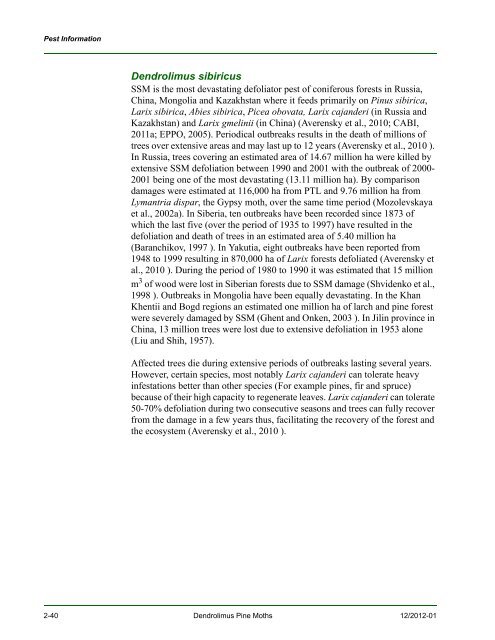New Pest Response Guidelines - aphis - US Department of Agriculture
New Pest Response Guidelines - aphis - US Department of Agriculture
New Pest Response Guidelines - aphis - US Department of Agriculture
You also want an ePaper? Increase the reach of your titles
YUMPU automatically turns print PDFs into web optimized ePapers that Google loves.
<strong>Pest</strong> Information<br />
Dendrolimus sibiricus<br />
SSM is the most devastating defoliator pest <strong>of</strong> coniferous forests in Russia,<br />
China, Mongolia and Kazakhstan where it feeds primarily on Pinus sibirica,<br />
Larix sibirica, Abies sibirica, Picea obovata, Larix cajanderi (in Russia and<br />
Kazakhstan) and Larix gmelinii (in China) (Averensky et al., 2010; CABI,<br />
2011a; EPPO, 2005). Periodical outbreaks results in the death <strong>of</strong> millions <strong>of</strong><br />
trees over extensive areas and may last up to 12 years (Averensky et al., 2010 ).<br />
In Russia, trees covering an estimated area <strong>of</strong> 14.67 million ha were killed by<br />
extensive SSM defoliation between 1990 and 2001 with the outbreak <strong>of</strong> 2000-<br />
2001 being one <strong>of</strong> the most devastating (13.11 million ha). By comparison<br />
damages were estimated at 116,000 ha from PTL and 9.76 million ha from<br />
Lymantria dispar, the Gypsy moth, over the same time period (Mozolevskaya<br />
et al., 2002a). In Siberia, ten outbreaks have been recorded since 1873 <strong>of</strong><br />
which the last five (over the period <strong>of</strong> 1935 to 1997) have resulted in the<br />
defoliation and death <strong>of</strong> trees in an estimated area <strong>of</strong> 5.40 million ha<br />
(Baranchikov, 1997 ). In Yakutia, eight outbreaks have been reported from<br />
1948 to 1999 resulting in 870,000 ha <strong>of</strong> Larix forests defoliated (Averensky et<br />
al., 2010 ). During the period <strong>of</strong> 1980 to 1990 it was estimated that 15 million<br />
m 3 <strong>of</strong> wood were lost in Siberian forests due to SSM damage (Shvidenko et al.,<br />
1998 ). Outbreaks in Mongolia have been equally devastating. In the Khan<br />
Khentii and Bogd regions an estimated one million ha <strong>of</strong> larch and pine forest<br />
were severely damaged by SSM (Ghent and Onken, 2003 ). In Jilin province in<br />
China, 13 million trees were lost due to extensive defoliation in 1953 alone<br />
(Liu and Shih, 1957).<br />
Affected trees die during extensive periods <strong>of</strong> outbreaks lasting several years.<br />
However, certain species, most notably Larix cajanderi can tolerate heavy<br />
infestations better than other species (For example pines, fir and spruce)<br />
because <strong>of</strong> their high capacity to regenerate leaves. Larix cajanderi can tolerate<br />
50-70% defoliation during two consecutive seasons and trees can fully recover<br />
from the damage in a few years thus, facilitating the recovery <strong>of</strong> the forest and<br />
the ecosystem (Averensky et al., 2010 ).<br />
2-40 Dendrolimus Pine Moths 12/2012-01

















